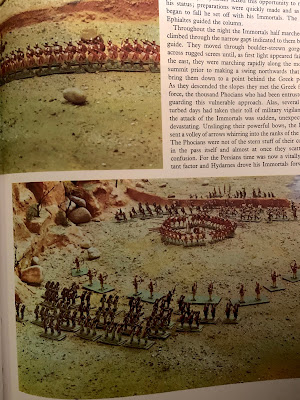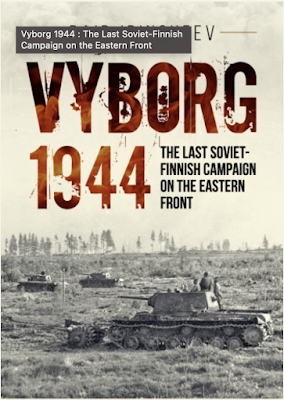The game I ordered a few weeks back for my wife to give me for Christmas (the one of which she said, 'don't bother getting me a birthday present, you getting this for yourself will be my present' [head scratching emoji]) was dutifully held back until Christmas Day. Over the last few days I've been examining the contents of the box and reading through the rules, trying to understand how to play it and how to combine it with table top miniatures for playing out battles.
 |
| The map is on an A1 size thick board (c2mm thick) |
This is going to take some effort. By which I mean understanding the game, not this blog post. I hope. I don't play many board games, and the last one I bought (Maria) took some time and effort to understand but was well worth the effort*. So maybe my brain isn't trained up to modern board game standard. It might therefore be a little unfair to say, this isn't all easy to get my head around. There were some bits I read and re-read in the rules, and was still puzzled, before the penny dropped. But I'll defer proper judgement until I've had a trial run through.
* In fact I thought that Maria was a beautifully produced and very cleverly constructed game
I'll probably write a few posts on it, for my own benefit; as part of my learning process. If I can describe it, I must be able to understand it, is my theory. If a side-benefit is it gives you an appreciation of the game so much the better. So my plan is to work through an overview of the game, and then work through the game sequencing and finally have a look at how I can use it in conjunction with miniatures. In effect, how I can use it to generate battles with a strategic context.
First things first, the game is based on the First English Civil War, 1642-46, for two players. It has a number of different scenarios with the full game covering all four and a half years, with each full year having 6 turns and 1642 having only 2. The 6th turn of each full year being a Winter Turn. Each Turn has 5 phases, except the Winter Turn which also has a Year End Phase when things are re-set for the following year**. So already it's beginning to sound a long game. 4 years by 5 turns by 5 phases = 100 phases. Plus 4 Winter Turns times 6 phases = 24 phases. Plus 2 turns times 5 phases = a further 10 phases for 1642 (no Winter Turn). Total = 134 phases, if my maths is correct. Admittedly some do look very brief. One of the phases in each turn is the Tactical Phase when Battles and Siege Combats are resolved. Battles and Siege Combats (Sallies and Storms) themselves have more than one round each, so whilst action is abstracted it doesn't look like it's over with a simple modified die roll. It may be that once I get into it, it will become clearer and actually be simple to enact. Siege Resolution occurs not in the Tactical Phase but in the Supply Phase.
** The Phases in turn are:
- Initiative
- Operational
- Tactical
- Supply
- Victory
- Year End (Winter Turn only)
There is a Victory Point Track (Royalist at one end and Parliamentarian at the other end) on which a marker is moved according to the relative achievement of VPs through the game. If for example, the King has 2 VPs and then Parliament wins one, the marker is moved on the tracker one place towards the Roundhead end, thus reducing the King's VPs to 1. A further 2 VPs to Parliament would mean Parliament is now on 1VP on the tracker. When one side reaches 3 VPs it wins a major victory in the war. Otherwise the game runs to the end of 1646. If a side has VPs it wins a minor victory. If neither side has VPs, the King wins a minor victory.
 |
| Labels for the blocks. Not my favourite part of assembling games like this - I'm not the neatest when it comes to applying labels. |
 |
| Blocks and part of a QRS |
The game is played out using blocks which represent either Leaders, Horse, Foot or Artillery. Each block has an Effectiveness rating and a Strength, which can be reduced by attrition or built back-up again. Initiative and ability to move blocks is determined by card. Some cards also have various events which can influence play during the turn. The cards differ between the two sides so there is a slight difference in events which might help or hinder the respective causes. Obviously cities and areas held differ at the start of the game and this can also influence replenishment of the armies.
 |
| A sample of the cards. The number at the top represent the Action Points for that turn, the letter below is the Phase in which it is played. Some Events can only be played in certain years. |
One issue ahead of me is how to convert blocks to table top units. My initial thought is taking the Effectiveness rating as the quality (raw, trained, veteran etc) and Strength as the number of units. Strength could be a problem if it leads to armies too big for my table or more units than I possess. I need to do a bit more arithmetic here to see how it would pan out. I'm not sure yet whether I would want to play out sallies and storms as a figure game or just use the rules from the game - probably the latter. I certainly don't intend to game the sieges per se on the table top. Apart from not having suitable models for the fortifications, I haven't settled on a set of siege rules.
The quality of the materials is good and the graphics are nice reproductions of period images. As well as the rule book, the game comes with a Playbook which I haven't read yet. It may help make more sense of some of the text in the rules.
 |
| Touch of Barkerese |
I'm looking forward to getting to grips with This War Without an Enemy and understanding it better over the next few days of my Christmas/New Year break. In fact I'd better get a move on. there's not much of it left!
All that remains is to wish you all a Happy New Year. Let's hope it turns out much better than 2020.









































